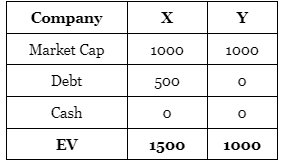
What is the difference between Stock Spilt, Right Issue & Bonus Issue?🤔
Let’s understand these terms⤵️
#stockmarketnews
Let’s understand these terms⤵️
#stockmarketnews
1⃣. Stock Split
A stock split means the company offers additional shares to existing shareholders with a lower value.
For Eg. A company issued a stock split of 1:2 with the current FV being Rs.10, which means additional shares will be given for each share held.
A stock split means the company offers additional shares to existing shareholders with a lower value.
For Eg. A company issued a stock split of 1:2 with the current FV being Rs.10, which means additional shares will be given for each share held.
Why do companies split shares?🤔
If shares are overvalued, companies dilute the shares by increasing the total shares outstanding but the market capitalisation remains the same.
They do this to make shares more appealing to individual shareholders.
If shares are overvalued, companies dilute the shares by increasing the total shares outstanding but the market capitalisation remains the same.
They do this to make shares more appealing to individual shareholders.
Companies may opt fr spilt if current share prices r overvalued & discouraging retail investors to make investment. Another reason may be no. of stocks will lead to liquidity fr investors.
Both reasons will help ease trading fr retail investors as price of stock will decrease
Both reasons will help ease trading fr retail investors as price of stock will decrease
2⃣. Reverse splits
Like splits, reverse splits force up the price of shares and reduce the number of shares in the market, at the same time increasing FV & share price.
Like splits, reverse splits force up the price of shares and reduce the number of shares in the market, at the same time increasing FV & share price.
For Eg, A company has issued a 2:1 reverse stock split with an FV of Rs.10 & share price of Rs. 900.
However, after a reverse split, the FV will be Rs.20 & share price will be Rs. 1800.
In this reverse split, investment value doesn’t increase.
However, after a reverse split, the FV will be Rs.20 & share price will be Rs. 1800.
In this reverse split, investment value doesn’t increase.
3⃣. Rights Issue
Through the rights issue of shares, the company invites shareholders to subscribe to additional shares at a discounted price from the company.
It allows companies to raise more capital for paying off obligations.
Through the rights issue of shares, the company invites shareholders to subscribe to additional shares at a discounted price from the company.
It allows companies to raise more capital for paying off obligations.
What happens in the right issue?
The shares are issued at a discounted price than the current price. This is done in order to entice the existing shareholders to invest again.
After the right issue, the market price of shares fell to accommodate the fresh issue.
The shares are issued at a discounted price than the current price. This is done in order to entice the existing shareholders to invest again.
After the right issue, the market price of shares fell to accommodate the fresh issue.
This doesn’t translate into a loss for existing shareholders because the price of discounted shares will make up for the fall.
4⃣. Bonus Issue
A bonus issue is the means by which the company offers additional shares to current shareholders for free.
It does not involve any cash outflow but changes the share capital structure without any change in underlying assets.
A bonus issue is the means by which the company offers additional shares to current shareholders for free.
It does not involve any cash outflow but changes the share capital structure without any change in underlying assets.
For Eg. A 3:1 bonus means that shareholder will get 3 shares for each share held by him.
Shareholders holding 100 shares will receive 300 bonus shares. Now the investor will own a total of 400 shares.
Shareholders holding 100 shares will receive 300 bonus shares. Now the investor will own a total of 400 shares.
What happens aftr the bonus is issued?
The retained earnings of the company come down & share capital rises to the extent of bonus shares issued
The net profit & total BV remains the same but due to increase in no. of shares the book value per share & earnings per share fall
The retained earnings of the company come down & share capital rises to the extent of bonus shares issued
The net profit & total BV remains the same but due to increase in no. of shares the book value per share & earnings per share fall
Thus, the price gets adjusted with the same proportion of bonus issues to maintain the same valuation level.
All these are corporate actions taken by the companies. Understanding these actions is important for shareholders to understand what impact it creates on their wealth.
All these are corporate actions taken by the companies. Understanding these actions is important for shareholders to understand what impact it creates on their wealth.
To learn about the Qualitative & Quantitative aspects of the company, do visit our interesting course of Value Investing on Quest which is now BSE Institute certified - bit.ly/quest-value-in…
• • •
Missing some Tweet in this thread? You can try to
force a refresh





